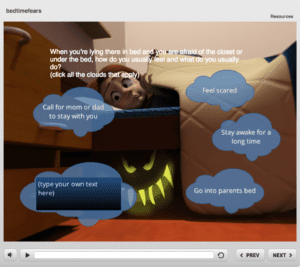How to Help Your Child Sleep Alone Without Anxiety
The Bedtime Hero Program for Nighttime Fears
Although it is common for a 6-12 year old child to be afraid to sleep alone at bedtime, they can overcome their fears with this simple step-by-step method.
Learning to conquer their fears is an important step in developing self-confidence and independence that will spread into all aspects of their lives. That's why, as a child psychiatrist with over 30 years experience, I created a method to help your school-aged child learn to sleep alone feeling confident and happy.
The Child Who Is Afraid to Sleep Alone
It started innocently enough .. Your child was too afraid to sleep one night for some reason, perhaps a nightmare, or perhaps an anxiety-producing event at school, perhaps a scary story they heard from a friend or on a video. Then, one night led to another and now your child has developed a fear of sleeping on their own. They need you to stay with them until they fall asleep. However, they are afraid to sleep alone and they are uncannily aware of when you try to leave.
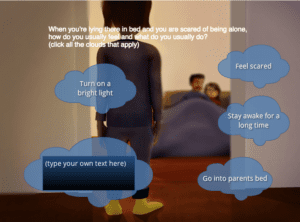
In their own bed your child may be afraid of the dark, afraid of someone breaking in, afraid of bad dreams or scary stories, afraid of sounds in the house or of monsters or zombies.
Maybe your child started coming into your bed during the night without you even knowing (or you were too tired to deal with it), and the next morning .. Surprise! There they are, happy as a clam!
If it goes on long enough they may refuse to sleep in their own room altogether. With enough tears, anxiety and upset you found it easier to let your child sleep in your bed because, after all, that’s where they always end up anyway! Or maybe you reached a compromise and allowed your child to sleep on a makeshift bed on the floor for now. You’ve tried being firm, maybe even applied punishments or rewards, all to no avail.
It’s understandable that you, as a parent, may be feeling increasingly concerned or frustrated. You may be getting tired of the arguments, the distress, the nights of disrupted sleep .. and you need this to stop.
How Common Is It?
Fears at bedtime are very common1. A study by Gordon, King, Gullone, Muris and Ollendick2 (2007) found that 64.2% of children and adolescents reported having nighttime fears. Another study (Owens, Spirito, McGuinn and Nobile3, 2000) reported the prevalence of significant sleep problems in children to be 37% in the general population. These are HUGE numbers. It means that 2 out of 3 children will have fears at bedtime at some point in their lives, and that 1 out of 3 children will have significant issues about going to sleep.
The Goal
The goal is not merely for your child to stay in their own bed at night, but for them to feel comfortable, confident and unafraid of sleeping on their own.
Understanding Sleep Anxiety in Your Child
What It Isn’t.
Anxiety at bedtime is not ..
- Difficulty falling asleep because of physical discomfort (i.e., too cold, too hot, too much light, too much noise, uncomfortable pillow, stuffy nose or cough from allergies or a cold, growing pains or other body pain). With these issues, addressing the physical problem is the thing to do.
- Anger or arguments about the time for bed. If a child is noncompliant or defiant simply because they want to stay up later, then doing some family counselling or a parenting course would be most helpful.
- Worries or stress about school. This may well be anxiety, but it is not about being afraid to sleep alone. If there are issues about school (i.e., the schoolwork, a teacher, a bully, conflict with friends, etc.), then address the specific issue, possibly with the help of the school, a counsellor, or doctor.
- Hyperactivity. Children with Attention-Deficit/Hyperactivity Disorder (ADHD) may have difficulty settling at bedtime, but this is not about the fear of sleeping alone. Medications for ADHD (e.g., methylphenidate or dextroamphetamine) can sometimes cause difficulty falling asleep. Trying a lower dose, an alternate medication, or using some melatonin may help.
What It Is
When we go to bed for the night we stop doing the things that keep our minds busy, which frees up our minds for thinking and imagination – for better or worse. Children think about things too, but their imaginations are much stronger and more vivid than adults. They realize that there are scary new threats in the world of which they were unaware before. Furthermore, they don’t have the life experience to know which things pose real threats and which do not.
So, when another child at school tells them the story of “Bloody Mary” who comes out of the mirror at night, or they watch a YouTube video about zombies, your child’s imagination can make things seem very real and frightening at night. If they hear about a murder or a child abduction on TV their natural tendency is to imagine it happening to them.
The Fear of Sleeping Alone Results From Three Types of Problems
Separation Anxiety Disorder
The primary issue in separation anxiety is that a child feels insecure and fearful when they are on their own. The anxiety is not limited to bedtime and often occurs during the day in a variety of situations. Here are the DSM-5 (the Diagnostic and Statistical Manual of Mental Disorders, 5th Edition) criteria for the diagnosis of Separation Anxiety Disorder. Note that each Category (A,B,C and D) must exist to make the diagnosis.
A. Developmentally inappropriate and excessive fear or anxiety concerning separation from those to whom the individual is attached, as evidenced by at least three of the following:
1. Recurrent excessive distress when anticipating or experiencing separation from home or from major attachment figures.
2. Persistent and excessive worry about losing major attachment figures or about possible harm to them, such as illness, injury, disasters, or death.
3. Persistent and excessive worry about experiencing an untoward event (e.g., getting lost, being kidnapped, having an accident, becoming ill) that causes separation from a major attachment figure.
4. Persistent reluctance or refusal to go out, away from home, to school, to work, or elsewhere because of fear of separation.
5. Persistent and excessive fear of or reluctance about being alone or without major attachment figures at home or in other settings.
6. Persistent reluctance or refusal to sleep away from home or to go to sleep without being near a major attachment figure.
7. Repeated nightmares involving the theme of separation.
8. Repeated complaints of physical symptoms (e.g., headaches, stomachaches, nausea, vomiting) when separation from major attachment figures occurs or is anticipated.
B. The fear, anxiety, or avoidance is persistent, lasting at least 4 weeks in children and adolescents and typically 6 months or more in adults.
C. The disturbance causes clinically significant distress or impairment in social, academic, occupational, or other important areas of functioning.
D. The disturbance is not better explained by another mental disorder, such as refusing to leave home because of excessive resistance to change in autism spectrum disorder; delusions or hallucinations concerning separation in psychotic disorders; refusal to go outside without a trusted companion in agoraphobia; worries about ill health or other harm befalling significant others in generalized anxiety disorder; or concerns about having an illness in illness anxiety disorder.
Post-Traumatic Stress Disorder
The underlying problem here is that a child has experienced a seriously traumatic event, such as physical abuse or a life-threatening accident. If the issue has not been resolved, frightening images related to the event will commonly resurface as the child is falling asleep causing anxiety in the child at bedtime.
Specific Fears
This is by far the most common reason for children being afraid to sleep alone. Based on descriptions from my patients over the years, there are 7 common fears that are the source of most nighttime anxieties ...
The 7 Common Bedtime Fears in Children
- Fear of being alone
- Fear of the dark
- Fear of the closet or under the bed
- Fear of sounds in the house
- Fear of someone breaking in
- Fear of waking in the night
- Fear of bad dreams or scary stories
(If your child suffers from frightening dreams, you might also want to check out this article on How to Deal with Nightmares in Children)
As you can see, Separation Anxiety Disorder directly relates to both the fear of being alone and the fear of waking in the night. Post-Traumatic Stress Disorder relates to the fear of bad dreams or scary stories, although the scary dream or story in the case of PTSD is based on a real event.
Most often, however, the child who is afraid to sleep alone has a specific fear and nothing more. Scary videos or movies, creepy stories told by other children, news about deaths or traumatic events, frightening weather, bad experiences, etc, can all trigger bedtime fears.
The Usual Advice (What Works and What Doesn’t)
In searching for advice on the Internet I found the following strategies, which I have listed below along with my recommendations:
- Maintain a consistent bedtime that ensures the right amount of sleep: Preschoolers (3-5 years) 11-12 hours; Early school-aged (6-9 years) 9-11 hours; Late school-aged (10-12 years) 8½-10 hours; Adolescents (13-18 years) 6½-10 hours1 – Recommended. Good advice, but does not address the child’s fear of sleeping alone.
- Have a bedtime routine - Recommended. Good advice, but does not address the child’s fear of sleeping alone.
- Spend some personal time before saying goodnight - Recommended. Good advice, but does not address the child’s fear of sleeping alone.
- Lying with your child – Not recommended. This reinforces the pattern of physical closeness. A child often becomes super aware of any sound or movement that indicates the parent is about to leave.
- Monster spray – Not recommended. If you have a monster spray doesn’t that confirm in your child’s mind that monsters actually exist? I think so. Instead, children need to understand that monsters and zombies really do not exist.
- Changing the bedroom environment (rearranging the furniture, redecorating, campouts) - Not recommended. This reinforces a pattern of avoiding scary things rather than facing them and dealing with them. Children need to learn that their bedroom is actually a secure and comfortable place and that a scary shadow is just a shadow, nothing more. This approach is built into my Bedtime Hero program (see below).
- Punishments - Not recommended. Their fear is real and not under their control, so this is a great way to actually increase a child’s anxiety at bedtime because now they are afraid of you too.
- Rewards – Recommended. As long as rewards are small and reasonable this can help orient a child towards success and motivate learning. This strategy is built into the Bedtime Hero program.
- Relaxation recordings - Not recommended. If a child is simply overactive or experiencing physical discomfort this may be helpful (see “What It Isn’t” above). However, it is actually quite difficult to "relax away" a specific bedtime fear.
- Night lights – Recommended, but only if they are very dim. Leaving the bedroom door open a crack or a small plugin night lite can be useful, but avoid bedroom lamps or overhead lights because this can actually interfere with the natural production of sleep-inducing melatonin in a child’s brain. This strategy is built into the Bedtime Hero program.
- Leaving music or a TV on or allowing electronic devices - Not recommended. Don’t allow your child to become dependent on these parent substitutes.
- Sleep on a floor bed - Recommended. This will not usually solve the problem by itself. However, if it can be combined with a program that helps the child overcome their fears and develop confidence, such as Bedtime Hero. The floor bed can then be moved gradually closer to the child’s own bedroom.
- Gradually extending time between checkins after the child goes to bed - Recommended. This strategy is built into the Bedtime Hero program.
- Melatonin or other sleep aids – Recommended, but only as a supplement to other strategies aimed at eliminating fears.
- Get rid of stimulants in the evening such as chocolate, caffeinated drinks (cola, energy drinks), cold medications containing ephedrine and certain medications - Recommended.
- Just let it run its course - Not recommended. In my experience, when parents simply struggle through the sleep problem or take their child to counselling that is not effective, it takes about 2 years for bedtime anxiety to runs its course. Also, when the sleep fears are not adequately corrected it also seems to make a child more prone to the development of other anxieties, such as social anxiety or performance anxiety. For this reason, I believe it is in the child’s best interest to learn how to overcome their fears, build their self-confidence and enjoy their success.
What Your Child Really Needs
Your child’s brain is incredible. Children are capable of learning much much faster than adults. They are able to use their imaginations in new and creative ways and with far greater ease than you or I. It’s like they possess a powerful supercomputer .. but have no idea how to really use it.
My goal is to help your child utilize that untapped mental resource to help them feel strong and confident when lying in bed alone. I want them to come up with their own effective strategies for achieving their goal .. sleeping comfortably on their own with no anxiety.
Therefore, I developed the interactive Bedtime Hero program that takes your child through the same step-by-step therapy method that I use in my office.
The Bedtime Hero Program
Bedtime Hero is an interactive online therapy program in which my voice guides your child through a series of steps with Disney-like animations. Your role is to assist and support your child as they work through the process.
Bedtime Hero uses the same series of therapeutic steps that I use with children in my office. My clinical research revealed that over 90% of my child patients with bedtime anxiety achieved significant improvement within 6 sessions using this method.
The Bedtime Hero program ..
- First asks them to identify how they usually feel, what they usually do and how things will turn out if they continue in that usual pattern when lying in bed alone,
- Helps them reach a decision to solve the problem,
- Asks them to envision their goal, the way they’d like things to be instead,
- Establishes the idea that feeling strong and confident is the best way to achieve their goal,
- Creates their personal power phrase,
- Asks them to identify a good experience from the past that is associated with strong confident good feelings,
- Blends the good memory into their experience of being alone in bed,
- Helps them problem-solve using a procedure to mix the two experiences together, and asks them to write down their ideas (with your assistance),
- Gives suggestions on ways they can think differently about their situation,
- Engages them in future-oriented mental rehearsals of sleeping in their own bed,
- Helps your child work through and resolve some or all of the 7 common fears,
- Allows your child to measure their level of anxiety as they deal with each fear they target, and feel encouraged as they witness their level of anxiety dropping,
- Encourages you and your child to work through the issues bit by bit over several sessions until they solve the problem,
- Finishes with a final session that actively helps your child lock in their gains with an extra boost of strength and confidence, complete with a new rating scale to measure how strong their feeling of confidence has become,
- The program works best for children aged 6 to 12 years.
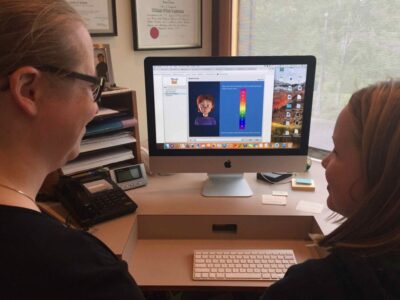
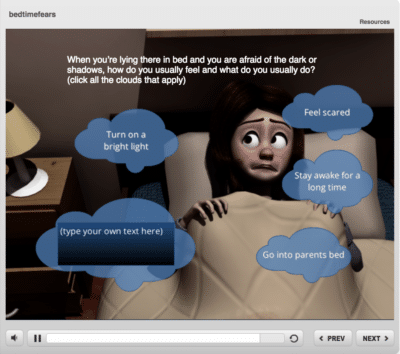
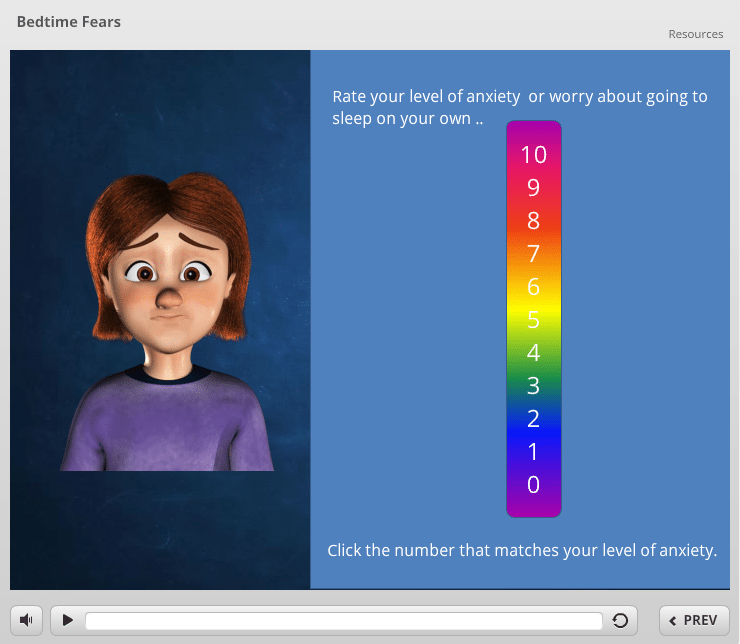
Other websites may talk about the importance of involving your child in the solution, but the strategies they describe often put the onus on you, the parent, to make things happen.
The key to this program is that it engages your child in actively solving the problem themselves. They become invested in the process and own their success. When an idea comes from within a child it has a much stronger effect than any idea coming from a grownup.
Sign Up Now to Receive Your Free QuickStart Email Series for Parents
PLUS
Your FREE Access to the Bedtime Hero Program
* Your email address will not be shared with anyone.
Learn more about the Bedtime Hero online therapy program ..
About Dr Lauderdale

Copyright © 2025 by W. Mark Lauderdale MD
All rights reserved.
"Hi Dr. Mark - Just wanted to send some feedback and a quick word of thanks for the Bedtime Hero program. For months, we have struggled to make any progress getting our 7 year old to sleep on her own. She becomes extremely anxious at bed time and everything we tried had little motivation for her - no reward or threat to take something away had any impact on her fear level. It just was real and we all couldn’t figure out any strategies to make improvement.
I figured there had to be some sort of therapy we could try and upon a quick Google I found Bedtime Hero. My daughter was super excited to try it cause it seemed cool, she desires to be better at bedtime, it was something we could do together and frankly, it just gave us a different way to come at this problem.
The first night she rated herself a level 10 anxious, and I would have to agree. She wasn’t even bluffing - she was terrified of sleeping on her own. Two nights in? She rated herself a 0. ?! Don’t get me wrong, we have a long way to go, but look at her confidence jump and she’s HAPPY. I can’t recall a day where she’s been happy in her bedtime routine. We love the tapping and thinking of good thoughts. This program resonated with her!
Wish us luck on continuing the journey, but I wanted to stop and say THANK YOU for this tool."
- Katie T.
References
- Owens, Judy A, and Mindell, Jodi A. Taking Charge of Your Child's Sleep. 2005. New York:Marlowe & Company.
- Gordon J, King N, Gullone E, Muris P, Ollendick TH. Nighttime fears of children and adolescents: frequency, content, severity, harm expectations, disclosure, and coping behaviours. Behaviour Research and Therapy 2007 Oct; 45(10): 2464-72.
- Owens JA, Spirito A, McGuinn M, Nobile C. Sleep habits and sleep disturbance in elementary school-aged children. Journal of Developmental and Behavioral Pediatrics 2000 Feb; 21(1): 27-36.
Bedtime Hero Reviews
Sleeping so much better
Our daughter had no problem falling asleep by herself but would wake up in the middle of the night and wake up her Mom. Then her and her Mom had a very hard time falling back asleep. They got irritated at each other and had to sleep in longer in the morning which ruined any plans. But now we’ve seen so much success with the Bedtime Hero! She and her Mom both are sleeping so much better. Thank you for this program!
Improved drastically
Bedtime improved drastically after first day using the program and is still going strong months later. The 10 minute check was a real game changer.
Much Improved!
This is not only about opening up communication between you and your child regarding their sleep routines; it is also about ‘training’ the parent to react differently to wake-ups and falling asleep times. Our child had a rough first few days, but we stuck with the 10 minutes in and then 10 minutes out, the rewards, and so on. About a month later, she was falling asleep before we came in for the first 10-minute check. She has been doing it consistently for months now.
She was also able to tell me what scared her at night, and she chose the modules that addressed her biggest fears. She really responded to the facts in the module about people breaking into her room; learning those facts was an obvious relief for her. She also learned that waking up in the middle of the night and yelling for me immediately was a habit—one that she could change.
As for training the parents, it gives us a different and better way to respond to and support our children. Instead of getting into bed with her in the middle of the night, I changed my approach: I sit on the floor, and she is usually asleep again in a minute or two. She rarely calls for me in the middle of the night anymore.
This program is excellent because it provides guidance to parents and a structured response for the kids. The timed interventions introduce a level of trust; they know you will come back in. I have recommended this to our friends whose children struggle with bedtime.
Such a simple and amazing program!
I was DESPERATE when I stumbled across this program in the middle of the night. My 6 year old who has never been a great sleeper had fallen into a pattern of not wanting to go to sleep and waking up 1-2 times a night for a few months “scared”. I was willing to try ANYTHING. The program worked almost immediately! We set an original goal of 7 nights in a row. After a few trial nights she slept until night 6. Then we reset with the intent of a small prize at the end of the week. She was successful! The next time we increased it to 14 days and have added on each time since then. So in the last 45 days she has slept all night at least 40 of them. It’s been amazing and she loves it!
Response from ShrinkinaBox
She’s a true BEDTIME HERO! Thank you so much for taking the time to submit your experience.
– All the best, Dr Lauderdale.
Transformational
2 years of extended bedtimes – usually 2 hrs of coming out and arguments. Now back to what an averagely good child would be like. Very grateful!
Helpful content
The program seemed to work well for my 6 year old son, especially rating his fear of sleeping downstairs in his room in his own bed. He is still sleeping on a cot in our upstairs spare bedroom outside of the room my husband and I sleep in, but we are working slowly to getting him back in his own bed sleeping independently.
Game changer
Our son was told a ghost story 18m ago. Since then he was scared to be alone and espcially at night would not sleep unless one of us was with him in the room. Every night he would get up and come into our bed. We tried all sorts of rewards and punishments and techniques to resolve it. We found shrinkinabox on the internet and gave it a go and it has made a huge difference.
Our son became motivated to improve the situation himself and was excited by the “money back guarantee” which made him confident that it would work.
The material is given in a way that gives kids confidence because it is direct and a professional third party speaking. He now comes to our bed rarely and is able to go to sleep by himself. We still come in every 15mins to check on him but it is huge improvement and his mood and energy have increased as a result.
Highly recommend this programme
Huge increase in confidence going to sleep on their own even if she has a bad dream she has been able to settle herself after waking from the dream. Our daughter has been sleeping with one of us for nearly a year and the change in her after one session was massive. She was initially not sure about taking part in the sessions but she has been able to use the technique to help her sleep on her own in her own bed something we didn’t think was going to happen again anytime soon. Thank you so much! I would highly recommend this programme to anyone whose child is experiencing difficulties sleeping on their own.
Confidence
My 6-year-old is feeling confident about sleeping alone after 2 weeks of using the program.
Confidence Level 9 out of 10
Our son was not falling asleep and coming into our bed. He slept through the night last night and has stayed in his bed every night since starting the program last week.
